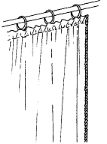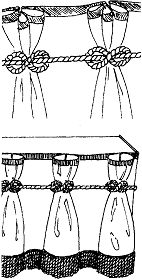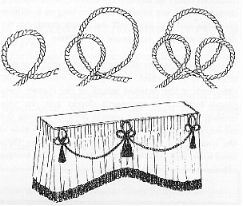HAND SEWN ROPE
Rope
simply sewn to the leading edges and hems of curtains makes a smart and
luxurious finish. Traditionally, it was sewn around curtains to protect the
edges of the fabric from wear and damage from sunlight. It must be attached
with small stitches. |
|
|
KNOTTED ROPE
Knotted rope can be sewn at the
base of French or goblet pleats, sewn along gathered headings, or used to
conceal the joins of coronets and trumpets. A convenient rope size is 12mm.
(1/2in) diameter.
Make an overhand loop and then a second loop. Pull
the ends of the rope to form the decorative knot. The right side is with the
figure of eight uppermost.
Tie the number of knots you need, leaving
the correct spacing between them. Sew the rope to the heading, either side of
the knot and also between them. Sew rope through from the front to the back of
the heading, or you can let the rope fall in scoops between the knots. |
ROPE CLOVERS
These are often used in the centre of
fixed headed curtains to disguise the seam that joins the curtains together at
the top. They can be used on valances, at the top of Roman, blinds, or over any
static heading.
Make the left hand loop measuring 19cm (71/2in) and
then make the centre loop behind it measuring 27cm (11in). Make the right hand
loop to mirror the left. Pin and sew through the base to secure.
Allow
about 65cm (251/2in) of rope per clover, although of course it can be made
smaller or larger.
|
Professional
tip
|



